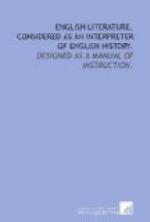Wilkie Collins, born 1824: he is the son of a landscape-painter, and is renowned for his curious and well-concealed plots, phantom-like characters, and striking effects. Among his novels the best known are: Antonina, The Dead Secret, The Woman in White, No Name, Armadale, The Moonstone, and Man and Wife. There is a sameness in these works; and yet it is evident that the author has put his invention on the rack to create new intrigues, and to mystify his reader from the beginning to the end of each story.
Charles Reade, born 1814: he is one of the most prolific writers of the day, as well as one of the most readable in all that he has written. He draws many impassioned scenes, and is as sensuous in literature as Rubens in art. Among his principal works are: White Lies, Love Me Little, Love Me Long; The Cloister and The Hearth; Hard Cash, and Griffith Gaunt, which convey little, if any, practical instruction. His Never Too Late to Mend is of great value in displaying the abuses of the prison system in England; and his Put Yourself in His Place is a very powerful attack upon the Trades’ Unions. A singular epigrammatic style keeps up the interest apart from the story.
Mary Russell Mitford, 1786-1855: she was a poet and a dramatist, but is chiefly known by her stories. In the collection called Our Village, she has presented beautiful and simple pictures of English country life which are at once touching and instructive.
Charlotte Mary Yonge, born 1823: among the many interesting works of this author, The Heir of Redclyff is the first and best. This was followed by Daisy Chain, Heartsease, The Clever Woman of the Family, and numerous other works of romance and of history,—all of which are valuable for their high tone of moral instruction and social manners.
Anthony Trollope, born 1815: he and his brother, Thomas Adolphus Trollope, are sons of that Mrs. Frances Trollope who abused our country in her work entitled The Domestic Manners of the Americans, in terms that were distasteful even to English critics. Anthony Trollope is a successful writer of society-novels, which, without being of the highest order, are faithful in their portraitures. Among those which have been very popular are: Barchester Towers, Framley Parsonage, Doctor Thorne, and Orley Farm, He travelled in the United States, and has published a work of discernment entitled North America. His brother Thomas is best known by his History of Florence to the Fall of the Republic.
Thomas Hughes, born 1823: the popular author of Tom Brown’s School-Days at Rugby, and Tom Brown at Oxford,—books which display the workings of these institutions, and set up a standard for English youth. The first is the best, and has made him famous.




